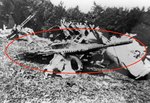The others don't compare with Caidin. You put up a picture of 'Zero' (with introduction by Japanese Navy ace Saburo Sakai) but his much more infamous book was "Samurai" supposedly by Sakai. But it turned out Caidin wrote the book based on notes by a translator from interviews with Sakai, Caidin didn't even meet him. A lot of errors in that book have been pointed out since; not just perception errors by Sakai about the success of his unit (claimed 5 really downed 2, that sort of thing, which is par for the course); but stuff that's wrong from the Japanese side. Maybe Sakai misrecalled some of it, but again the book was apparently very lightly researched to fix any of that. The lack of confidence that any given statement in there really came from Sakai makes it an almost useless book IMO.Martin Caidin? Why, what's he done?
It's a growing list since joining this forum. William Green, Bill Gunston, Eric Brown and Dr Alfred Price are just a few I have read that are regarded as 'doubtful' here. The bookshelf is shrinking. Any others?
As FBJ said, the Italian P-38/YB-40 story is notorious Caidin tall tale with only the very loosest basis in fact (which doesn't relate to YB-40's).
Eric Brown: his best known book, "Duels in the Sky", is IMO very readable and entertaining, and somewhat informative too. As most know a lot of the book is Brown's comparatives of various WWII types that really met or didn't, a lot of the same stuff that's debated on forums such as this one. I have no problem with the book itself, just quotations from it that treat it as some kind of holy scripture. The comparisons are with benefit of Brown's test pilot experience, but not necessarily with benefit of actual combat results which Brown wasn't apparently as expert about.
Green: prolific writer about WWII types a long time ago; later writers in part inspired by people like him have found new and better info in many cases.
Gunston: more a modern a/c writer AFAIK, not WWII; very prolific, and often writing speculating about stuff for which better info eventually comes out.
Alfred Price: I don't know the problem is supposed to be with Price, nobody is perfect but IMO he's the highest quality writer you mentioned. Maybe people criticize Price for other things but cases I recall have been about his Osprey series book on Spitfire V aces cataloging the failure of Spit V's v Zeroes over Darwin 1943, and actually quite light Japanese losses, combat by combat. That topic strikes a funny nerve in some people, for whatever reason. But Price's source there is pretty clearly the Japanese official history (agrees with it anyway). He's not making it up or getting it from me or something
Price is a professional author (retired RAF IIRC) who writes a lot of books, not a part timer who gives long term heart and soul to one topic, and those are different approaches. But in general he's among the better of prolific pro's IMO. His "History of US Electronic Warfare" 3 vols. is among the best military topic books around, because he understands that difficult topic and explains it very well.
Joe

